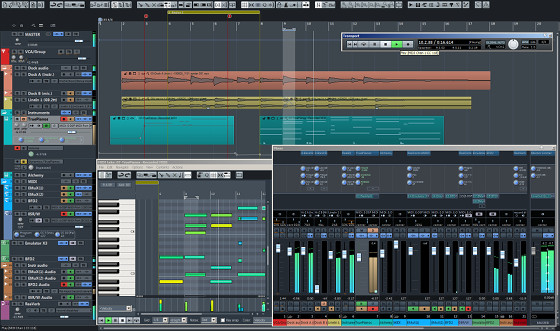

But once you’ve finished defining all the Regions you wish to use, you can start experimenting with Region Playlists via the Region Playlists window, so run the Action ‘SWS/S&M: Open/close Region Playlist window’. You can navigate between Regions (and markers for that matter) in Reaper by using the default ‘’ keys, and that can be useful while fine-tuning things. Incidentally, if you’re working with lots of markers, the same window allows you to edit multiple markers too - just check the Regions and Markers tickboxes a the top right of this window to show/hide them. Alternatively, the default key command is a potentially finger-twisting Cmd-Opt-Shift-R. To access this window, go to ‘Edit Region.’ as before, and this time hit the ‘Region Manager.’ button.

It can get a bit tedious setting up Regions one by one, so I find that it’s better to run through your project making your selections and defining your Regions, and then opening the Region/Marker Manager window, where you can edit the name, timings, colour and default numeric identifier for all your Regions in one place. While Regions can be edited individually, the Region Manager window offers a much more convenient means of tweaking and colouring multiple Regions. There’s also the intriguing ‘Region Render Matrix.’ button, which we’ll leave for another time. The ‘Edit Region.’ command also allows you to define a suitable name for your Region, and to refine the selection by typing in the start Position and Length manually - you do so in whatever units you have selected to display on the timeline, so you can make time-based or bar/beats-based selections, or get down to single-sample accuracy if required.
Reaper daw pro#
When you create a Region, you should see a numbered, grey strip appear on the main project page’s timeline above your selection(s) - well, in both the default theme and the Pro Tools 12 one I usually use it’s grey I’ve not checked any of the more out-there themes you might be using! You’ll probably want to give each Region a different colour for ease of navigation, and you can do so by right-clicking, selecting ‘Edit Region.’ and in the resulting pop-up hitting the ‘Set color.’ button. There are also a couple of useful self-explanatory Actions that allow you to create Regions from each of the currently selected clips: ‘SWS/BR: Create Regions from selected items (name by item’s notes)’ or ‘SWS: Create Regions from selected items (name by active take)’. To do this, make your time selection and right-click either in empty space or on the timeline, and select ‘Create Region From Selection’ - or use the default key command Shift-R. Assuming you’ve already installed the SWS Extensions (you can find instructions via the URL above) then start by defining a Region in your song - a basic verse or chorus structure, perhaps, or a loop that you might want to repeat numerous times. Getting Startedįire up a Reaper project with some basic ideas for a song, or a song that you might like to try rearranging. What’s more, you can create different Playlists and audition them all before committing to one (or more) and having it ‘flattened’ to give you a more traditional project structure running in linear fashion along the timeline. (You can, of course, use more meaningful names than Region 1, such as Verse, Chorus, Bridge, Outro and so on!) As you play your Playlist back, you’ll see the playhead hop about the project according to the Playlist you’ve defined in the Region Playlist window. So you can tell Reaper to, say, play Region 1 once, Region 2 twice, and go back and play Region 1 once again before moving on to Region 3, irrespective of where those Regions exist on the project timeline. Regions are a bit like markers, except that they span a user-defined period of time, rather than simply marking a single point on the timeline, and the facility allows you to create ‘Playlists’ that can play back those Regions in any order you like. In a nutshell, it builds on Reaper’s ability to define separate ‘Regions’ on the project timeline. If you haven’t already installed the SWS Extensions for Reaper, then you really should barely a session goes by when I don’t find a useful new function in there: you can find them at This month, I want to take you through SWS’s ‘Region Playlists’ facility, which gives Reaper users lots of the functionality that the DAW world first saw in Cubase’s Play Order (now Arranger) Track. Reaper’s Region Playlists make it easy to sketch out new song structures or rework existing tracks. You can create regions in Reaper based either on the current timeline selection or, via some Actions, on the currently selected clips.


 0 kommentar(er)
0 kommentar(er)
